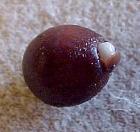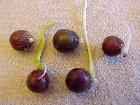Germination in vitro:
future for the
Victoria amazonica seeds?
Page 2
Back to Page 1

Course 40
Royal Botanic Gardens, Kew
by Renata Mazzini
Click images to enlarge
Acknowledgements - References - About the author
§ The results:
Viability tests were done at the Paradise Garden, with nicked and unnicked seeds from the lots used in this experiment. The seeds were "sown" in water.

As it says in the chart, even the nicked seeds from the LOT 03A12 were the less viable ones.
The results obtained from the experiments (loam, water, GA3 and agar) from each lot, were very variable, as follow. All the seeds that sprouted were considered.



| Loam: | ||
| . Few seeds germinated in loam, and the results were equal between the nicked seeds and the unnicked ones; | ||
| . There is not any problem related to the seedlings transplant. They usually grow very healthily, and are only transplanted once they have reached the 3 or 4-leaf stage; | ||
| . Even though no seed from the Lot 03A12 has germinated in loam, it did not represent the results, obtained in USA, with other composts. | ||
| Water: | ||
| . The seeds in water do sprout quicker than those in loam, but the filiform leaf does not grow afterwards. It might be because the water was changed only once during these 35 days. | ||
| . The restricted growth is not because of lack of air inside the plastic bag. At the Paradise Garden they also germinate their seeds inside plastic bags, and as mentioned before, they have got the best results through this way. | ||
 |
 |
|
Knotts Photos |
|
 |
|
|
|
|
| Gibberellic Acid (GA3): | ||
| . Gibberellic Acid can make the sprouting faster, but the same as in water happens with GA3: the filiform leaf does not grow, but it might improve the germination rate, especially in the unnicked seeds. | ||
| Agar: | ||
| . It seems that agar is a good medium for germinating Victoria amazonica seeds. It gave good results, even for unnicked seeds. Once the seeds have sprouted, they grow very quick, even in the tiny flasks, where they were originally. After the filiform leaf, the first and second leaves grow very fast too, and then they have to be transplanted as soon as possible. The agar has to be washed away to prevent spread of contamination. The seedlings are supposed to be a bit more fragile than those ones grown in loam, because they were in a protected "environment". Victoria roots do not like to be disturbed, but only one of the transplanted seedlings died. | ||
None of the seeds from 1996, sown in loam, germinated.
 |
|
Last day that the seeds, sown in loam for this project, were checked |
Every year, Victoria seeds are sown at Kew. Only 3 plants are needed: one of each specie - amazonica and cruziana, and one of the hybrid 'Longwood Hybrid'. Although there has not been any problem so far, no seed of Victoria amazonica, sown as part of the gardens' routine, has germinated this year, and very few germinated in loam. There is no apparent reason for that, so it might be the light intensity and the day length. The seeds were sown in early February, when there were days with around 4 hours of sunshine only . That number increases in March, to 10 hours. There is a computer that keeps the light luminosity inside the glasshouse at the minimum of 80 watts/m2, during 13 hours a day, from 9 in the morning to 7 in the evening, when the light outside drops lower than this number. This is considered the minimum that the plants need. In the middle of March, light luminosity outside was over 100 watts/m2, but it can not be compared yet to the Amazon, where light luminosity can be variable from 800 to 1200 watts/m2. It is a big difference that really can affect the plant germination and growth.
The number of sown seeds is not enough to consider the experiment as a scientific experiment, but it can demonstrate already that loam and agar present the best results.
Although the micropropagation laboratory facilities were not provided for these experiments, the agar could secure a good number of plants, and also it made the germination faster. Very few seeds were presumed contaminated, but they survived after being washed out and transplanted from the agar to the loam. The seeds in agar were sown 13 days later than those ones sown in loam. The following chart shows the number of seeds that germinated day by day in both loam and agar.

The "nicking" seed process can be difficult without practice, but it proved worth doing when a fast germination is required.
It is important to keep a new stock of seeds, as none of the old Victoria amazonica seed germinated this year.
It is more secure to keep a stock with new seeds every year.
Experiments with a good number of seeds must be done to be sure about the best germination compost. Gibberellic Acid (GA3) could be tested in both agar and loam.
In the future, when a good number of plants may be needed, agar could be the best compost to use. Even if the micropropagation laboratory facilities can not be used, seeds can be sown in "near sterile" conditions. Minor contamination did not seem to affect the seedlings. Agar is not so expensive - 500 grams cost around £85.
Seeds could be sown a bit later, in early March, when the light luminosity is slightly higher. Or the light inside the glasshouse can be set for more than 80 watts/m2.
The storage temperature could be maintained at 24°C, as the Paradise Garden and people from The Victoria Conservancy do. They have been doing many experiments related to that, and found this temperature the best one.
Acknowledgements - References - About the author
|
|
||
|
|
|
Articles |
|
|
|
|
|
|
|
|